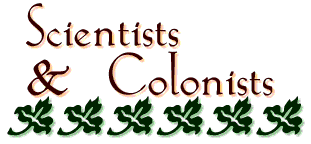

Despite Australia's current wealth as a scientific nation, the pursuit of science was not a high priority in the minds of Australia's first Europeans. Survival in this "new" and very different continent far outranked scientific endeavour.
Several Royal Societies existed, but did not welcome the general public. They were headed by scientists from overseas and the few people practicing science as a career usually worked for wealthy British patrons.
Government funding for science was rare. A few inadequately-funded government astronomers and geologists recorded weather and located minerals. Unless there was an immediate and practical benefit from science, the young Australian colonies were not prepared to fund basic research.
One politician said, in response to a scientist's request for some funding, that if it "didn't affect the price of beef and mutton", he wouldn't "spend a shilling on it"! (1)
Following the gold rushes of the 1850s, the colonies became more prosperous, and attitudes began to change. Colonial governments funded museums or occasional scientific publications. Scientists were earning less than a bullock driver by the end of the century, but it was a change for them to be paid at all!
Australian scientific unity was consolidated in 1888, when Archibald Liversidge and his supporters founded the Australasian Association for the Advancement of Science (AAAS, later ANZAAS). AAAS had members from each colony and encouraged broad public involvement. The first AAAS meeting in 1888 brought 850 members to Sydney and was met by an enthusiastic press.
At this time gentlemen scientists of the scientific societies, such as engineer Henry Deane, chemist/geologist Archibald Liversidge, botanists Ferdinand von Mueller and Joseph Maiden, and astronomer Robert Ellery began to engage the interest and involvement of the general public. They gave public lectures, wrote popular texts on scientific subjects, revamped museums, and established science classes. Families were encouraged to go to the bush or sea-side to observe and collect specimens.
As leaders of society, these gentlemen felt obliged to improve the mental, moral and physical quality of the Australian population. If the colonists could be induced to "lend a helping hand to science", the colonies would prosper; while the colonists would elevate their own minds and morals by going out into the natural world.
Scientific societies soon began to meet in their own buildings; museums of natural history, geology and mining opened at times suitable for working class citizens; public lectures on microscopes and forest management were given to full halls; and science columns ran regularly in the newspapers. Membership of scientific societies grew steadily and included both scientists and interested amateurs. Less active members, along with sympathetic citizens, donated funds for building and exploration.
Projects included observing the heavens and weather, and collecting specimens of Australian animals, plants and minerals. Practical problems of water and electricity supply, disposal of waste, and control of disease were tackled with apparent enthusiasm and pride.
During the nineteenth century, Australian scientific enterprise developed to
a solid establishment that played an active role in the colonists' lives.
Australians began to think about science as a career. By Federation in 1901,
science was here to stay.
This article is based upon Jennifer Newell's BA Honours thesis - 'Scientists and Colonists: Efforts to Involve the Public in Science in Late Nineteenth-Century Australia', Australian National University, June 1992.
Jennifer Newell is a research and editing assistant at the Centre for Cross-Cultural Research, Australian National University.
(1) H.C. Russell BA CMG FRS, 'Inaugural Address' Report of the First Meeting of the AAAS Sydney, 1888, pp. 8-14, p. 13.